2024 in Review: The Year in Albums, Songs, LP Packages and More
Plus my 100-track end-of-year playlist and why its penultimate track means so much to me.
Just when it looked like all those 2024-in-review posts had dried up, along comes the slowcoach, bringing up the rear at the rear end of the year.
I’d like to say that this is late because I’ve been keeping my cool, holding back until it really was the end of the year to post my reflections. But I know it doesn’t work that way. Even if I didn’t want to be one of the first (which, by my reckoning, would have involved deciding on my albums and songs of the year in October), I didn’t intend to be one of the last.
In the end, it was a combination of illness, moving around and attending to non-writing matters that kept me from posting this until now. To be honest, I wondered if it was worth it. I decided that it was, even if only to get some thoughts down for myself. I hope they may be of interest to others.
The Year in Listening
In some ways my 2024 listening favourites reflect the kind of music I write about most on Substack, and in some ways they don’t. Most of my posts are serving the bigger project of my ongoing Songs and Objects book project, so the book’s themes and concepts steer me towards particular topics or case studies. Also, the focus in many of my posts is on songs, singers and songwriters whose work has influenced my thinking for a long time, and that means that I don’t write about as much new music as I would do if I were, say, sharing recommendations, doing reviews, responding to hot topics, and that kind of thing.
I still try to listen widely, though I feel my listening is not as diverse as it was ten, fifteen or twenty years ago. I blame that partly on limited time and partly on algorithms, both of which I feel have pushed me towards hearing a lot of material that is similar to what I’ve enjoyed before. I have mixed feelings about that.
That reliance on the algorithm in recent years has paralleled a reduction in subscriptions to music magazines, radio and other sources of information about new music. Again, this has been a time management issue for me. I got to a point with my magazine subscriptions a few years ago where piles of unread issues were accumulating and causing a kind of anxiety that I felt I needed to put a stop to.
Increased consumption of music writing on Substack over the last year has made me aware of lots of music, though hasn’t led to me following up as much as I’d like to: too much time spent reading, and not enough listening! I’ve enjoyed reading the many end-of-year lists that have appeared on Substack, and I’ve made notes of several things I’d like to explore further. What I haven’t done this year, but which I’ve often done before, is lots of cramming to try and get to hear as much of the stuff I missed as possible and add it to my always-on-the-go annual playlist before the year is out.
I’m taking things slower at present, doing other things in life that take me away from the decades-long search for new-to-me sounds, that often take me away from listening to music altogether (but not to the world: I keep my ears open to the world around me). We can’t do everything, and I’ve put my non-day-job productivity towards various things this year, only one of which is regular writing about things I want to write about. I’m happy with that choice.
The Year in Albums
As a lover of physical media, I used to take the occasional chance on a record or CD without listening to them first. I can’t afford to do that now (arguably I never could), so I always listen to music online first, compiling playlists for each year. For things that particularly grab me, I buy physical versions, usually records, though I can’t say I’m consistent with which things I choose to purchase and which I’m happy to only listen to as digital files.
Unless otherwise stated, the albums I’m writing about here are ones I have physical copies of, but I’ve also included a Spotify playlist at the end of the post which features 100 tracks that have been the sound of my year as far as new recordings go. Which reminds me: another reason I may have slowed down on keeping up with new sounds is the amount of time I’ve spent with older ones this year (see above on time spent researching and writing).
I am well aware that Spotify is problematic, both in terms of how it fails to reward artists and in the ways it steers listeners to more of the same rather than to new sounds. As someone who teaches courses on music and media, I’ve been pointing students towards the work of critics like Liz Pelly for some years now, and I’m very much looking forward to reading Pelly’s new book on Spotify in the coming weeks. I’m planning on making 2025 the year where I change the way I curate the digital side of my listening. I already use Bandcamp a lot and will be providing Bandcamp links where available in this post for the tracks I single out. It’s partly that I couldn’t have made my whole playlist with Bandcamp that has kept me (perhaps lazily) continuing to use Spotify for sharing, but that’s something I’m looking to change in the future. I’m quite excited about getting away from my reliance on the behemoth.
Enough of that for now. On to some of the albums that stood out for me this year.
Hurray for the Riff Raff, The Past Is Still Alive. ‘Alibi’ was the song that hooked me in, and the one I kept on my edited (i.e. no-more-than-one-track-per-featured album) 100-track playlist. But it could have been any track from this excellent album, which showcased Alynda Segarra’s ways with words and melodies as well as any of its predecessors. This year, as well as listening to this and previous HftRR albums, it’s been enjoyable to follow Segarra’s Substack, Resist Psychic Death.
Johnny Blue Skies, Passage du Desir. I’ve been an on-and-off listener to Sturgill Simpson over the years, never quite following him completely from one project to the next but trying to keep track of him all the same. This album under his new alias was the one that really did it for me. I was surprised by that initially, as I might have thought I’d have less time for an album with so many of the hallmarks of polished 1970s southern rock than I would for something more rootsy. But I fell in love with the songs, the voice and the beautiful slow-burning sound of Passage du Desir. Again, it’s hard to pick a single track as this is a whole-album experience, but I opted for ‘One for the Road’ as an example of pace and structure and for the long guitar solo that cruises through its second half.
Myriam Gendron, Mayday. This was an album gifted to me by the algorithm; I don’t believe I’d heard Myriam Gendron’s music before the behemoth offered it up as a suggestion. I’d love to tell a more organic story of how I discovered this beautiful, earthy music, but I’d be lying. I have a hazy memory of Gendron’s Dorothy Parker album being suggested to me a few years back via one of the old-fashioned methods—a record shop recommendation, I think, though it could have been from a newsletter or album review—but I didn’t follow it up at the time. I’m so glad to know this music now. Gendron’s take on folk song is beguiling as she switches between English and French, and I love the minimalist approach that she takes. Again, the production is great and the sound lends itself beautifully to intimate listening sessions.
This was another album that I took a few songs from for the longer (10 hour +) version of my 2024 playlist. For the edited version, I’ve gone with ‘Long Way Home’, but it was a tough choice between this and ‘Lully Lullay’, a track that benefits from Marisa Anderson’s guitar and Jim White’s drums.
Gendron’s was one of several albums in a folkish vein that I enjoyed this year. It sat very well next to Jake Xerxes Fussell’s When I’m Called (an excellent addition to this singer-guitarist’s consistently brilliant releases), Adrianne Lenker’s Bright Future, Bonny Light Horseman’s Keep Me on Your Mind/See You Free and Laura Marling’s Patterns in Repeat (an album which inspired me to write a long piece about patterns, loops and connections as I’d experienced them in my life). Marling, incidentally, is another musician whose erudite writings it’s been enjoyable to follow on Substack.
I say ‘folkish’ because these albums often had little in common with the closer-to-home folk material I’ve been listening to this year, including Lankum, ØXN, Landless, Lisa O’Neill and Stick in the Wheel, whose A Thousand Pokes was a late-2024 highlight. Lankum were the stars of many year-end lists in 2023 (including mine), but it was only at the start of this year that I saw them live for the first time, when they brought their brilliant concert to Newcastle in January.
Going back to some of the artists I mention above (Gendron, Marling, Lenker, Johnny Blue Skies), I think there’s a category of slow burners that has been an important part of my listening year. This would also include Jennifer Castle, Cassandra Jenkins and Arooj Aftab. Perhaps I just mean a bunch of albums that I can safely put on at volume late at night without bothering the neighbours, though I think there’s more to the aesthetic than this.
Songs for the night they are, though. Not the kind of you go dancing into, perhaps, more the kind you fade into, ‘on waves of your perfume’ as Arooj Aftab’s nocturnal ‘Whiskey’ puts it. In my recent post on ‘the deep time of song’, I wrote the following about the night:
What would songs be without the night? What would our interaction with music be without the night? The night belongs to lovers and to singers. I look to a lover or a singer to help me make it through the night. Sometimes I want a singer to brighten my night. More often, because singers can’t always be heard above the din of the brightest nights, I look to them to comfort, console and warm me in the wee small hours.
Aftab’s Night Reign album captures that feeling sublimely. ‘I’m drunk and you’re insane / Tell me how we will get home’, she sings in ‘Whiskey’, a song about being out and a bit lost and with that feeling of disappearing into the night. I’ve not had many nights like that of late (though I remember them well); for me, the song works beautifully as a soundtrack for nursing a glass at home.
I’ve selected the Mahogany Session version of ‘Whiskey’ for the playlist as it brings Gyan Riley’s guitar work to the fore more than the album version.
Thinking about how I was drawn to a certain ambience in the music I returned to most this year, I would want to flag the importance of albums such as Masayoshi Fujita’s Migratory, Shabaka’s Perceive Its Beauty, Acknowledge Its Grace, Patricia Wolf’s The Secret Lives of Birds and, perhaps oddly, Bell Witch’s The Clandestine Gate (an album from 2023 that I played a lot in 2024 after securing a vinyl copy).
A couple of live albums landed with me this year. One was Jason Isbell’s Live from the Ryman Vol. 2, which was a nice preparation for seeing Isbell and the 400 Unit perform in Stockton-on-Tees last month (an excellent gig). Another was Bill Callahan’s Resuscitate, which inspired me to write one of only a few full album reviews this year (the others were for older albums having anniversary years: see below).
The Year in Songs
For well over a decade, my main way of keeping a record of what I’ve been listening to each year is to save new release albums as playlists in a Spotify folder titled after the year (the oldest I can see on my current folders is 2012; I think I’ve been doing this for longer, but too many changes to the Spotify interface over the years have made it hard to find older playlists). I also keep another playlist within that folder, also named after the year, in which I put the standout tracks from the albums I’ve been listening to. By the end of the year I have a very long playlist, from which I’ll edit down to about 100 tracks, normally somewhere between seven and eight hours of music.
Prior to Spotify, I made iTunes playlists, which I’d burn to one or two CDs at the end of the year. Before that, I’d manually record to CDRs from CD or vinyl. And before that, because I’m of that age, I’d use cassettes.
The switch to Spotify has led to bloat, to my playlists getting longer and longer. While I still admire the discipline of whittling down to the lengths required by older formats, I don’t tend to do that anymore. As with other activities (writing, running, lecturing), I favour the long form, the chance to go on digressive and/or progressive journeys. Just as I know that I reduce the number of my potential readers by writing long posts, so I am perfectly aware that I can’t expect many people (if any) to spend one third of a day with one of my playlists. I make them anyway.
Such long journeys inevitably involve changes in landscape. My playlists typically open with a patch of more beat-based tracks, a reminder that, despite what comes later, I don’t spend all my time moping to mellow mood music. I think of this as the ‘catchy’ section: tracks that are catchy to me, but also that I think visitors who are staying long enough to have their visit soundtracked will be energised by. Some years contain more EDM and global beats than others. This year’s doesn’t have many examples, but there are some (Four Tet, Maurice Louca, Djorge Cadet, Ibibio Sound Machine).
The catchy/beat section also tends to include some of the more high-profile pop releases of the year. There’s not as much of that this year as I might normally add. Charli XCX is there—I didn’t have a brat summer, but that wasn’t down to any issues with Charli’s excellent album; I was just too busy or too confused/not the target for all that brat. Taylor’s not in my playlist, though she often has been before; again, I found the rollout of The Tortured Poets Department too confusing and messy, plus I didn’t spend long enough with the songs or manage to get to any of the concerts. Sabrina didn’t land with me, but that’s okay. Billie’s there, and so is Beyoncé.
Slightly subverting the catchy beat-based section, I’m sharing a link below to ‘Scaled to Survive’, a song from Leyla McCalla’s album Sun Without the Heat, though the song I chose to keep on the playlist was another track from the album, ‘Take Me Away’. I wanted the latter to sit next to Beyoncé’s ‘Texas Hold ‘Em’, Richard Thompson’s ‘Turnstile Casanova’ and Eliza Carthy performing Linda Thompson’s ‘That’s the Way the Polka Goes’ because I think all of them show innovative ways of bringing roots music into contemporary song styles. These aren’t artists I would necessarily think of together outside of the playlist format—though I might connect one pair via McCalla’s former bandmate Rhiannon Giddens performing on Beyoncé’s album, and there are obvious links between Richard and Linda Thompson—so the coincidence of them all releasing songs which I enjoyed helped me think about sonic patterns, which is always something I like to do. (I was tempted to add the title track to Stick in the Wheel’s A Thousand Pokes to this group, but I opted instead for their take on ‘A Brisk Lad’ in a later section of the playlist.)
‘Take Me Away’ for the playlist, then, but I love the quirky tuning and the slipping and sliding melody of ‘Scaled to Survive’, so am including that one here, along with what McCalla wrote on social media when the song was released as a single and video:
“Scaled to Survive” is about being born and also about giving birth. This song was inspired by Alexis Pauline Gumbs’ powerful book ‘Undrowned’ where she studies marine mammals from a Black feminist lens and offers observations and recipes for survival - “Thank you for laughing me into this portal,” she wrote.
That portal line is a lyric in the song, one that really jumped out at me, so I was grateful to find out its prehistory.
As for jazz, I like a through-thread of lyric-based tracks on my playlist so will include less jazz tracks there than I listen to on vinyl. I struggle to think of a lot of the jazz I play as playlist material, which is a bit odd given my appreciation for a good jazz compilation, especially a vinyl one that places two or three medium-to-longish pieces in conversation with each other. My jazz listening this year is picked up in a couple of the other sections below; acts that made the playlist include The Messthetics & James Brandon Lewis, Ezra Collective, Chris Potter, Carlos Bica, Raphael Roginski and Charles Lloyd.
If there’s relatively little jazz on my list, there’s barely any hip hop; Ka (RIP), Deca & Dealz and local (to me) ‘sincerity rapper’ Faithful Johannes and collaborator Neocia make my list. If I’m honest, I’m a bit at sea with contemporary hip hop, so this paucity doesn’t surprise me.
Inevitably there will be a long patch of song-based material on the list that will often include elements of country, folk, singer-songwriter, ambient and slow-burn tracks. Increasingly, there will be more female voices than male in this section. I’ll occasionally break these long stretches of rootsy/ambient songs with instrumental pieces. One example this year is the inclusion of ‘Rites and Rituals’, a track from the excellent album Ancient City by Paola Prestini and Nelson Patton that offers an interval between the wordy tracks that precede it and two fragile vocal gems by Sierra Ferrell (‘Lighthouse’) and Bonny Light Horseman (‘Keep Me on Your Mind’).
Similarly, a piece by Italian composer Rosa Brunello—‘From the Ground Up’, featuring Egyptian musician Maurice Louca, who also appears elsewhere on the playlist—bridges another run of songs that sit comfortably together.
Swimming Bell, the project of singer-songwriter Katie Schottland, was an early favourite in my loose genre of slow-burn tracks. Appearing in January 2024, Charlie has been on my playlist longer than most releases this year. I don’t know whether it was due to the early release date or underexposure, but I haven’t been seeing this featuring on year-end lists that are favouring similar material. The track I left on the playlist is ‘Take It Easy’.
Consistently excellent songwriters like Joe Pug and John Moreland are likely to make my annual lists when they have new material out, another way in which discoveries from the past shape my present and future listening. Pug and Moreland were both artists who I discovered through algorithms rather than reading reviews of their work or having them otherwise recommended by another human. Again, I’m not saying this is the best way for things to happen—I’d generally prefer to get recommendations from people I know and/or respect—but I’m glad the following songs found their way into my life.
I’m likely to write more about Joe Pug in future posts on Songs and Objects. For now, I just want to note how ‘Treasury of Prayers’ works both as a way of reimagining the list song (something I write about a lot) and as a great title for the album on which it appears, suggesting each track is a prayer of one sort or another.
The Year in LP packaging
Some of my favourite album covers from this year : Linda Thompson, Proxy Music; Beyoncé, Cowboy Carter [the horse cover]'; Ana Lua Caiano, Vou Ficar Neste Quadrado; Masayoshi Fugita, Migratory; Jennifer Castle, Camelot; Faithful Johannes & Neocia, The House at Night.
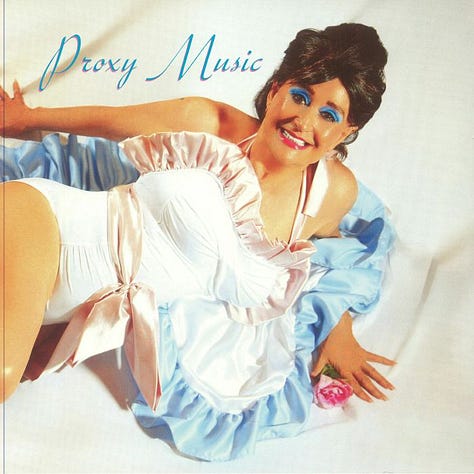
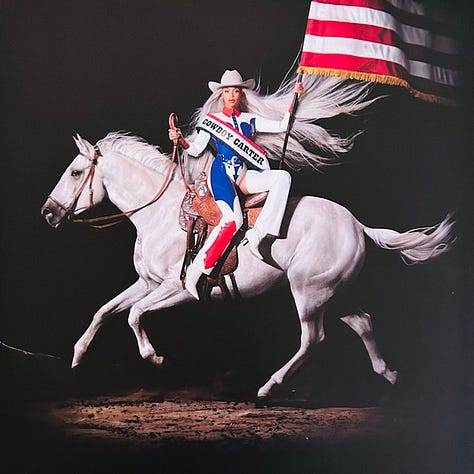
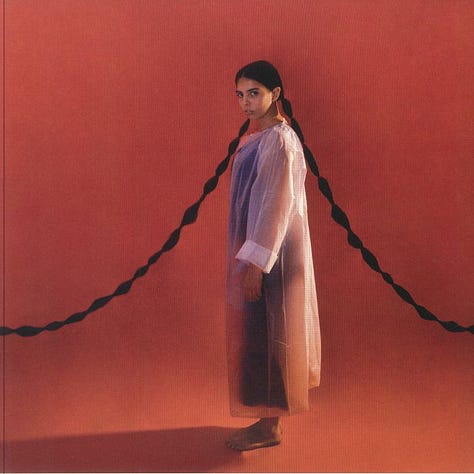
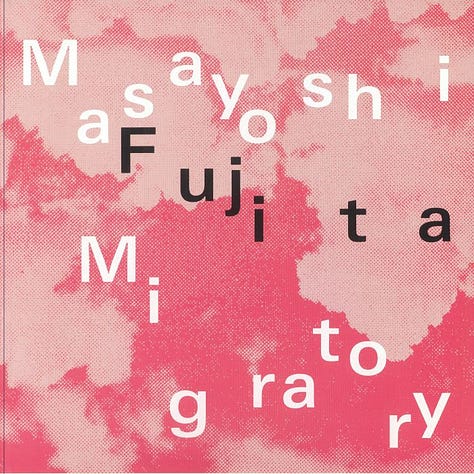
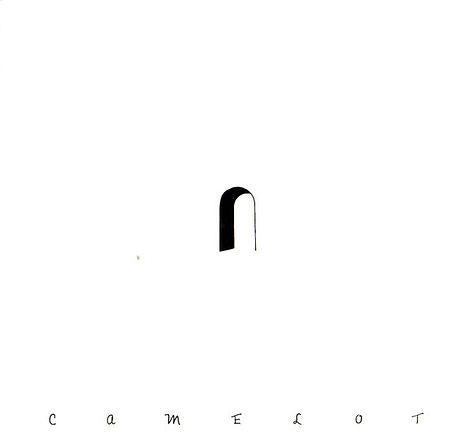

This gallery is drawn from albums I listened to a lot. I’m aware there were some brilliant covers from albums I didn’t buy or listen to.
As my three posts on the art of the record label showed, I’m quite the fan of how physical media gets presented and what connections there might be between the sonic, textual and visual elements of albums. I love the following albums for their music, not just their sleeves and labels. I just saved writing about them for this section so that I could highlight the whole package.
Cassandra Jenkins, My Light, My Destroyer. As well as having a striking pair of labels, this album also has a great cover and inner sleeve. An additional feature which I treasure is the decoration of the inside, or reverse, of the sleeves: not the inner gatefold, but the actual sleeve that the record goes into and which you wouldn’t expect to be decorated given its inaccessibility. I think the first time I experienced that was with Neil Young’s On the Beach and I’ve appreciated the small number of examples I’ve seen since then.


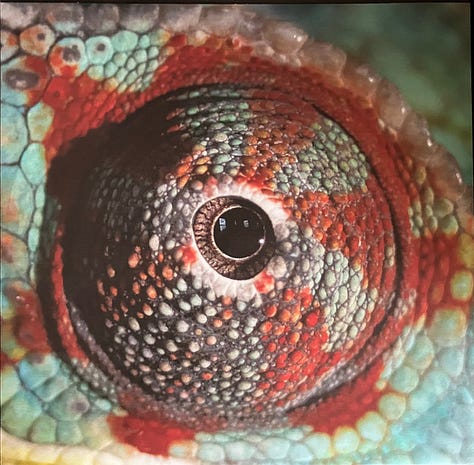
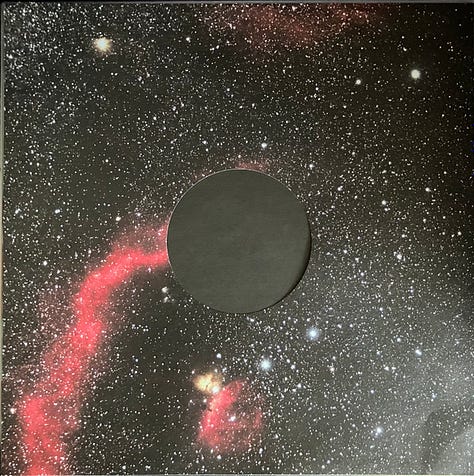

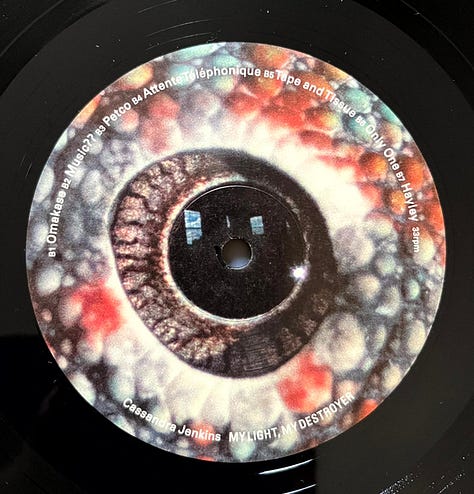
Musically, this was a favourite of mine from this year: great songcraft, vivid lyrical imagery and some gorgeous sound samples combining to make a constellation that I could lose myself in over and over. The song I put on the playlist is ‘Aurora, IL’: slow burning sadness, lyrics that link personal introspection with cosmic wonder, lines that remind me of Jason Lytle/Grandaddy in places, vocal-guitar textures that remind me of Mazzy Star.
A billionaire in Texas built a rocket ship to send the oldest man in space up on a pleasure trip and when he came down crying on the local news he couldn’t stop taking about the colour blue
Just beautiful.
Jennifer Castle, Camelot. I loved the huge, impractical poster that contained the lyrics and a bunch of illustrations as weird and wonderful as those in Jenkins’ album. In Castle’s case, I often find the lyrics as baffling as the illustrations, though I cherish her rhyme schemes and sonic patterns. The large poster reminds me again of Neil Young, who would often include large lyric posters in his 1970s albums. These songs build on the fractured beauty of Castle’s previous work like Monarch Season (which also had beautiful packaging): a great record to play next to My Light, My Destroyer, Mayday or Night Reign.
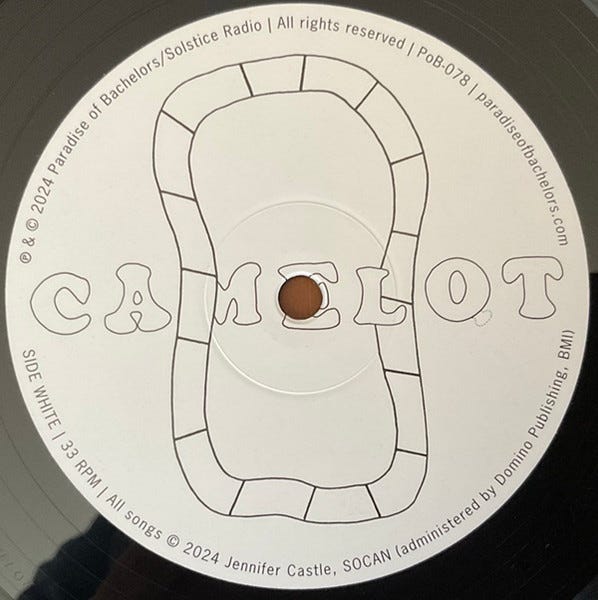
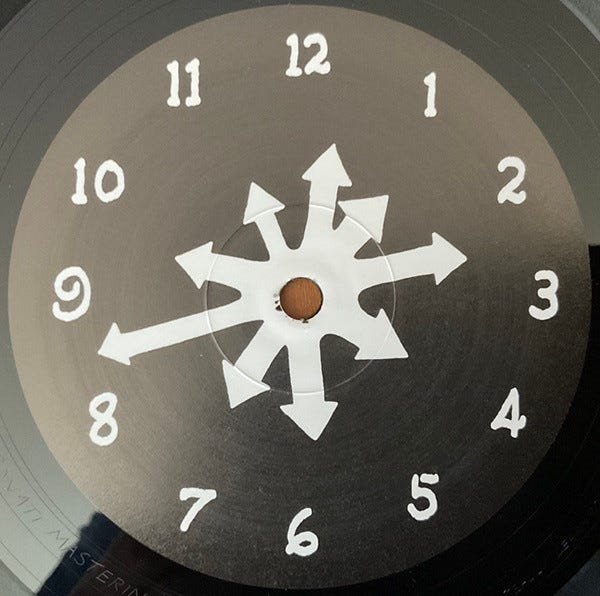
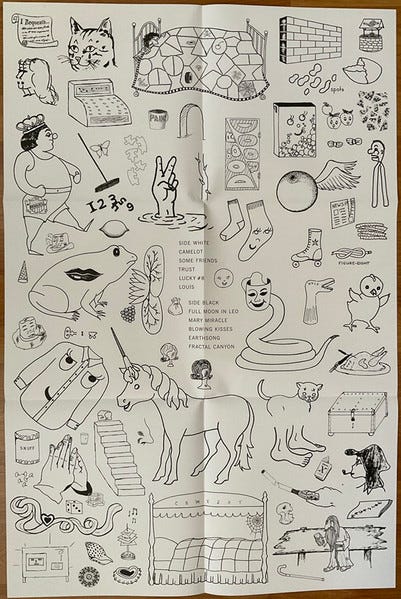
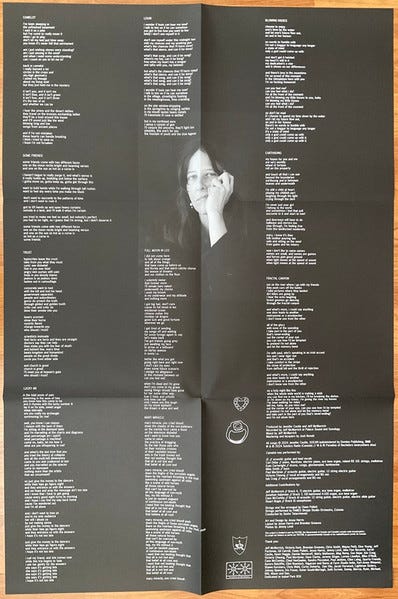
While we’re on fold-out posters for listing album credits, a shout-out to Father John Misty’s Mahashmashana, released just in time for those end-of-year lists that take their time rather than rushing out judgements at the start of November. Great illustrations, a lovely overall package to enjoy while listening to these often lengthy songs.
I was alternately charmed and bugged by the tiny glittery stars that kept falling out of the ‘Coke Bottle Clear, Pop Star Edition’ of Chappell Roan’s The Rise & Fall of a Midwest Princess released earlier this year. This was, of course, a 2023 album, but available to us vinyl lovers in 2024.
My copy of the Johnny Blue Skies album came on metallic gold vinyl, with a gorgeous blue label that matches the lyric sheet. With its old-fashioned tip-on jacket, the whole package feels great and complements the fabulous music.

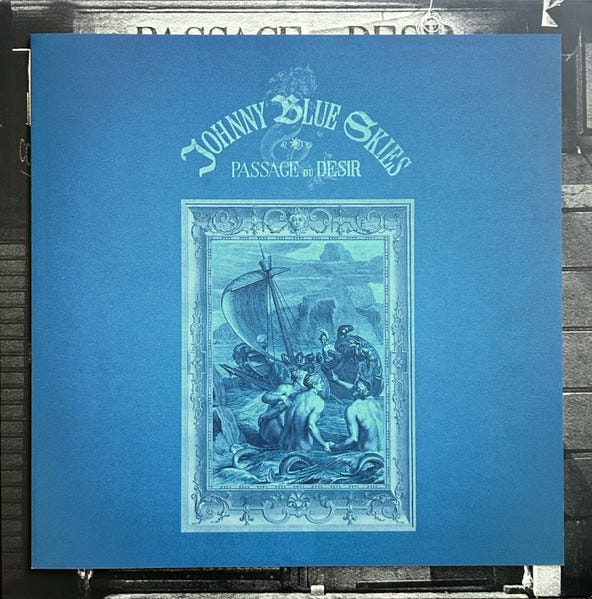
Lest this seem too much fetishizing, let me add that, ever since I started buying records regularly, I’ve always seen attention to detail in packaging as a bonus rather than a reason to buy or collect. I’ve rarely (if ever) been a collector of specific editions, though I’ve ended up purchasing several. In the few years in my twenties when I bought and sold second hand vinyl, I always prioritised affordability over catering for the collector’s market. And, while I find Discogs a valuable platform as both research aid and marketplace, I still refuse to participate in the kind of audiophile descriptions of editions or hifi kit you find in the comments there. I appreciate my Chappell Roan coke bottle vinyl, but I’m not going to start comparing it with editions collected by a bunch of other men because I won’t be buying any other editions. Ditto for The Tortured Poets Department (happy with my Smoke Gray version) and Cowboy Carter (the ‘beads’ rear cover).
The Year in Willie Nelson Records
Another year, another batch of new and reissued Willie Nelson albums. I have equal love for the two studio albums from 2024, The Border and Last Leaf on the Tree.
In the year I wrote and spoke about Trigger, it was good to see Willie’s faithful guitar credited and photographed (by Pamela Springsteen) on the inner sleeve of The Border. Even better to hear the instrument at work: the guitar on the title track is stunning. The Border felt like a classic Willie country album, with a mixture of songs co-written by Willie alongside covers of Nashville songwriters. Lots of pedal steel and Mickey Raphael’s harmonica.
I tried searching ‘Willie Nelson The Border’ on Bandcamp and got the following visual for ‘no matching results’, which seems kind of apt.
Here’s a video instead.
If The Border had echoes of the Nashville-meets-Texas-country albums that Wille has long traded in, Last Leaf harked back to projects like Across the Borderline (still in my top five Willie albums of all time, and with another great border-themed title track), with covers of artists from outside the country genre. To hear Nelson cover Neil Young’s ‘Broken Arrow’ was extraordinary, the way all the studio trickery and edits of the original are rendered as if part of a song you would sing and play on your acoustic guitar.
‘Last Leaf’, the track, provided inspiration for my second Willie Nelson talk of the year (not available yet on Substack: basically a version of ‘Willie Nelson’s Hands’ that puts less emphasis on visuals and more on lyrics and voice) and for a piece I wrote about leaves as metaphors in songs. It was also the track that made it to my playlist.
2024 also brought the reissue of Phases and Stages, a Willie Nelson concept album that was very much on my mind when writing my recent piece on the deep time of song, though I didn’t write about it in detail there. It’s a fabulous set of songs that fit well with Willie’s career-long exploration of time, age and experience.
This year’s Record Store Day saw the release of a second double-vinyl selection of performances from the celebration of Willie’s ninetieth birthday in 2023. The tracks on Long Story Short Vol. II had been available digitally, but it was gratifying to get them on record to go with the first volume from last year.
Being a longtime subscriber to the Willie Nelson email list, I’m used to getting regular information about concerts I can’t attend (Willie hasn’t played outside the US for years) and merch I’m unlikely to buy. The following grabbed me enough to share in a Substack Note in May.
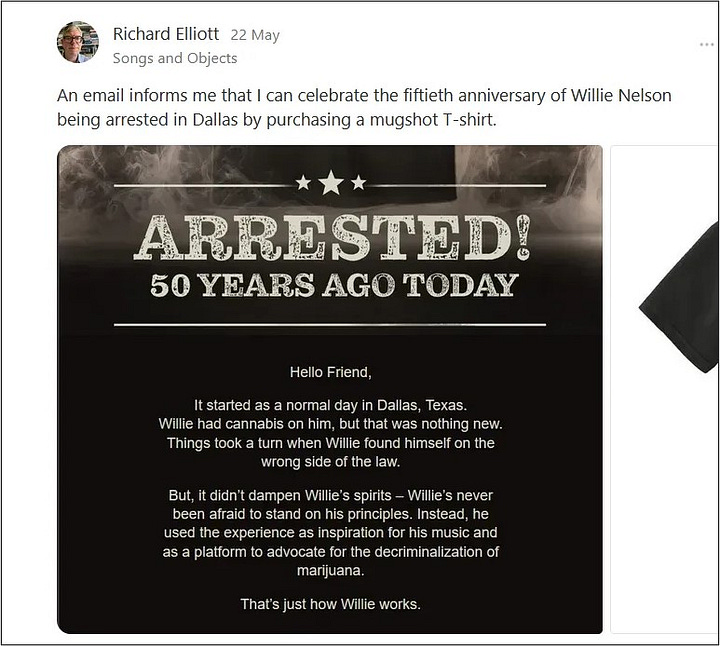
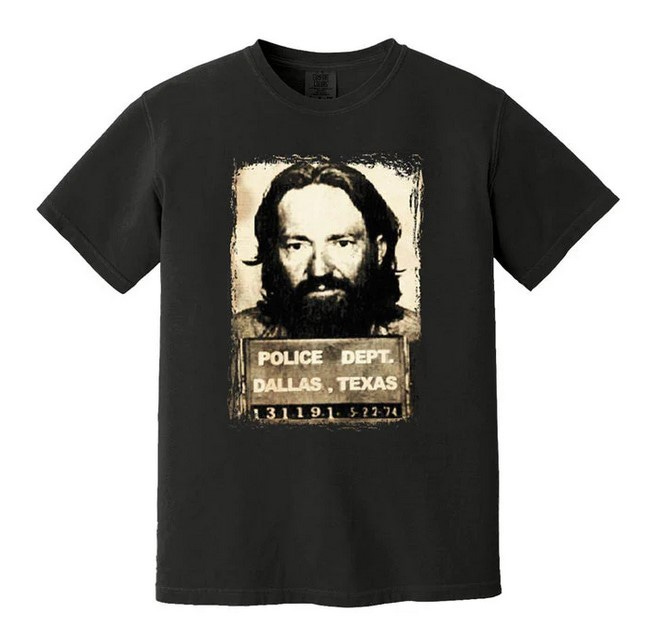
Which brings me to …
The Year in Anniversaries
To do this seriously would require a whole post, perhaps one with a framing narrative about why so many of us get excited enough about anniversaries of album releases or musician’s births or deaths to spend money on lavish reissue packages and/or to decide to write about them.
Some examples which led me to write lengthy pieces this year: what would have been Townes Van Zandt’s eightieth birthday; the fiftieth anniversary of Robert Wyatt’s masterpiece Rock Bottom; a vinyl reissue of Iris DeMent’s My Life to mark its thirtieth.
One I didn’t write about, but a record I played a lot: Willie Nelson’s City of New Orleans (1984). Another I’d have written about had I a bit more time: Neil Young’s On the Beach (fifty years old).
The Year in Reissues, Archives and Tributes
I’ve already mentioned some reissues that I spent time with this year, from Willie Nelson and Iris DeMent. The vinyl package for Aphex Twin’s Selected Ambient Works Volume II (Expanded Edition) was amazing and its coded record labels are a design classic (I should have included it in the section on packaging above, but this is already quite long). Another way to think about ambience, and plenty of music to get lost in.
Neil Young & Crazy Horse’s Dume is an expansion of the 1975 Zuma album. Talking with a friend about the necessity of this. I couldn’t dispute his observation that a classic like Zuma this doesn’t need to be messed around with. Even so, I enjoyed having the Point Dume sessions available on a double album and hearing a reimagined version of a beloved album. I loved the packaging too, which paralleled the sonic expansion by providing some new visuals based on the original designs. Nice sturdy card with a nice-to-touch matt finish and, inside, a fold-out poster with lyrics. The labels used a 1970s Reprise design and the whole thing felt just right.
Alice Coltrane’s The Carnegie Hall Concert was a joy to pick up on vinyl. Another set of recordings to listen to without distraction, to travel to other planes to, to be uplifted by.
Dennis Bovell, Sufferer Sounds. Another late-2024 release, this album collects hard-to- find dubs and jams by Bovell from his mid-late 1970s period with the Jah Sufferer Sound System. There are many things I love about dub: the rhythms, the emphasis on drum and bass, the hypnotic, trancey otherworldliness, the sometimes-rough-sometimes-smooth tensions. From a song studies perspective, though, I’m fascinated with the way that dub excavates the layers within any given song, how it shows songs to be endlessly malleable objects. Jazz singers can do this too, as can experimental composers and, of course, other remixers. There’s something about hearing dub on vinyl, though, that tends to make this my genre of choice when it comes to the sonic archaeology of songs.
Janet Kay’s ‘Silly Games’ is such an iconic 1970s vocal track that one might reasonably wish it to just be left alone. And yet …
I like a good tribute album. Favourites from recent years have included The Endless Coloured Ways: The Songs of Nick Drake, More than a Whisper: Celebrating the Music of Nanci Griffith and Something Borrowed, Something New: A Tribute to John Anderson. I suppose I could include the aforementioned Willie Nelson concert records in this category too. This year I enjoyed Petty Country: A Country Music Celebration of Tom Petty, featuring versions by many musicians whose work I enjoy. Standouts for me were Luke Combs’ ‘Runnin’ Down a Dream’, Dolly Parton’s ‘Southern Accents’ (see below), Dierks Bentley’s ‘American Girl’, Willie & Lukas Nelson’s ‘Angel Dream No. 2’, and a brilliant reading of ‘Don’t Come Around Here No More’ by Rhiannon Giddens, the Silkroad Ensemble and Benmont Tench.
Hearing Dolly Parton sing about that drunk tank in Atalanta on ‘Southern Accents’ was fun, but really it was the way she brought herself to the song that made it so moving, especially at the end: ‘I’m proud of who I am / a Southern girl from a Southern town / I ain’t ashamed, I ain’t ashamed, I ain’t ashamed … I got my own way of livin’. The video got me too; for just a second there, I was dreaming.
The Year in Songs About Place
This section is, in fact, only about one song, though it reflects, or refracts, a wider commitment I have to thinking about song’s connection to place. That’s been a major feature of the writing I’ve published this year, whether I’m discussing mud, leaves, patterns, running, or the songs of Richard Dawson.
Dawson acts as a connection for the final song I’m sharing here, which is by Nev Clay. Nev is a Newcastle-based singer-songwriter who has been performing on the local scene for over three decades, occasionally releasing new songs on EPs and singles. He’s also been a mentor to many other musicians in the area, including Dawson, who can regularly be found singing his praises. I first heard about Nev through Dawson and have seen the pair of them perform on the same bill on a few occasions. Nev is a beguiling live performer, who frequently prefaces and interrupts his songs with lengthy tales, observations and digressions, some of which are even related to the song he’s singing at the time.
Nev’s charm and humour come through nicely in a feature from earlier this year in Narc magazine, published to coincide with the release of an album—only his second in thirty years—called, aptly, So Little Happened for So Long. I wrote a bit about one of the songs, ‘Green Leaves’, back in October. The song I’ve cherished most from the album, though, is ‘Cuddy’s Cave’. It’s one of my songs of the year. My placing it at no. 99 in my playlist, just before the very final track (Charles Lloyd’s ‘Homeward Dove’) is not a marker of low esteem, but the very opposite: it’s the song I want to hear at the end of my 2024 soundtrack, a track that I can be sure will settle me back in place after a long journey.
I grew up in Devon, in the South West of England. The towns and, more permanently, the moorland and coast of that country shaped me and will always be part of who I am. But I’ve now spent seventeen years of my life in the North East and it is this region that informs most of my connections to place these days. I’ll always feel something of an outsider here, but the towns, villages, moors and coast of this part of the world are as part of who I am now as the landscape of my youth.
This explains why I find ‘Cuddy’s Cave’ so moving. The song consists of a recitation of place names and cultural phenomena of the North East. It’s essentially a list song of the kind I’ve written about before, building its power from the accumulation of listed items and the way they fit sonically.
Lee Fisher describes the song and its long gestation in his Narc piece:
It’s a sprawling hymn to the North East, a Geordie American Trilogy, that grew variously out of earlier songs (Nev dates version one to 2013) and a collaboration with St James Infirmary. The gorgeous, epic album version is version 24 and there are more on the way, often including rhyming couplets sourced from friends. So remarkable is Cuddy’s Cave that Gary Lang’s Maplestreet Press has published a small-press book about it, complete with lyrics, notes, sources and a beautiful cover painting by Narbi Price (this is indicative of how Nev likes to work, collaborating with friends and keeping it in the family).
For me, the song challenges the idea that lists without context don’t mean anything, though there is a context—again, a very moving one—that comes in the last part of the song, where first person references suddenly bring the songwriter into the frame.
Just before Christmas, Nev Clay released a video he’d made in collaboration with Jason Thompson to accompany the song. It shows Thompson’s beautiful shots of Northumberland and footage of Nev walking between Yeavering Bell and Cuddy's Cave, two of the places mentioned in the song.
Listening to So Little Happened for So Long on a drive from Edinburgh to Newcastle last month, driving through snow-spattered Northumberland in the beautiful, almost blinding light cast by a low winter sun, I thought about how ‘Cuddy’s Cave’ says so much about the region in such a moving way, and how Clay’s album as a whole is a collation of the musical life of the area. It’s an album with all the collaborative spirit that Nev’s followers have come to identify with this songwriter and mentor, and the credits read like a who’s who of a chunk of the local scene.
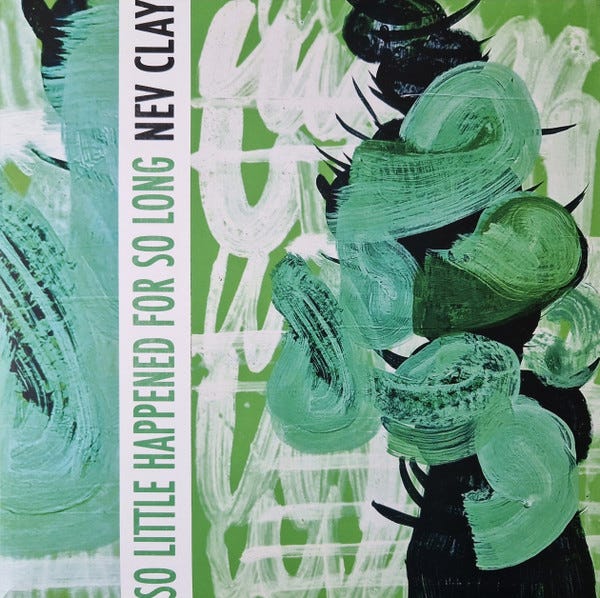
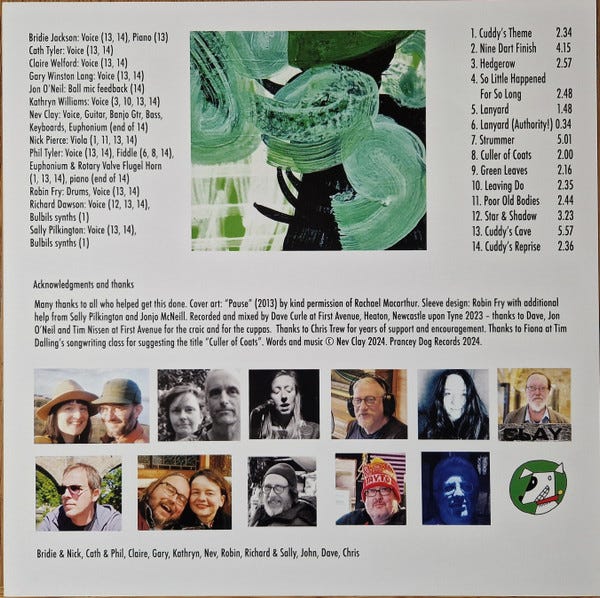
That spirit of collaboration is also to be found in another video for ‘Cuddy’s Cave’ that Nev has just released, featuring fifty two voices reading the lyrics over Northumbrian Piper Chris Ormston’s composition ‘The Low Lights of North Shields’.
Reading the comments under the videos confirms that the process of distilling a region into a list song has triggered people’s sense of place. How strongly one reacts to that will, to a large extent, depend on how familiar one is with the reference points. I would guess that almost all of them will be familiar to people who grew up here, a large majority to people like me who have lived here a long time, a smaller amount to people from elsewhere in the UK, and perhaps very few or none to people from other parts of the world. That tension between locality and universality is one that has cropped up in several conversations I’ve had with other writers on Substack this year and will no doubt continue to be an interesting one to pursue. For now, though, for me, this song has nailed something quite special, and I’ll be returning to it often.
The Playlist
For anyone who would like to see and hear the full 100-song playlist I ended up with, here it is. I’d be interested in hearing people’s thoughts.





Wow Richard, that was, seriously, several articles in one. You are a deep thinker and listener and I have happily transferred your Top 100 to my Qobuz account and look forward to upping my 210+ from 2024 by many more. I do kind of wish this had been broken up into separate articles as there is plenty to observe also here about artwork and themes and more. I guess that, just as I made the point that we have more good music on tap than ever, a platform like Substack ensures that we have more good writing about good music than ever. Here's to more happy listening in 2025.
I thoroughly enjoyed this write-up, Richard. I know, yet don't know, a lot of the albums and artists on your playlist, if that makes sense. The names of many are familiar, but I haven't explored their music. While others are new to me. I have saved your playlist to spin, however. It's refreshing to see a lot of different stuff on your list compared to many others I have seen these past few weeks!
And, on that note… curiously, I have limited myself to making playlists the same length as a cassette (no longer than 120 min), and I tell myself I can't repeat artists; they only get one song. Silly rules I set myself when I made tapes. Strange that I still hold myself to these arbitrary and silly rules.
I have enjoyed reading your pieces this year and look forward to your work in 2025. Happy New Year from Vancouver, BC (my wife and I are currently in the city to see in the New Year).